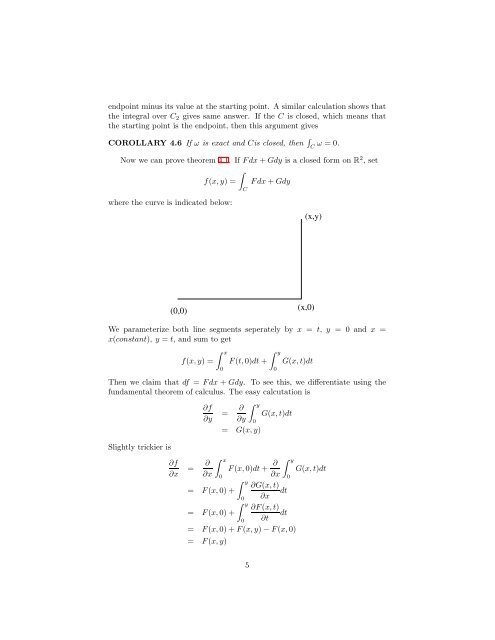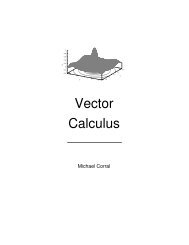Introduction to differential forms
Introduction to differential forms
Introduction to differential forms
You also want an ePaper? Increase the reach of your titles
YUMPU automatically turns print PDFs into web optimized ePapers that Google loves.
endpoint minus its value at the starting point. A similar calculation shows that<br />
the integral over C 2 gives same answer. If the C is closed, which means that<br />
the starting point is the endpoint, then this argument gives<br />
COROLLARY 4.6 If ω is exact and Cis closed, then ∫ C ω = 0.<br />
Now we can prove theorem 4.1. If F dx + Gdy is a closed form on R 2 , set<br />
∫<br />
f(x, y) = F dx + Gdy<br />
where the curve is indicated below:<br />
C<br />
(x,y)<br />
(0,0)<br />
(x,0)<br />
We parameterize both line segments seperately by x = t, y = 0 and x =<br />
x(constant), y = t, and sum <strong>to</strong> get<br />
f(x, y) =<br />
∫ x<br />
F (t, 0)dt +<br />
∫ y<br />
0<br />
0<br />
G(x, t)dt<br />
Then we claim that df = F dx + Gdy. To see this, we differentiate using the<br />
fundamental theorem of calculus. The easy calcutation is<br />
∂f<br />
∂y<br />
∫ y<br />
= ∂ G(x, t)dt<br />
∂y 0<br />
= G(x, y)<br />
Slightly trickier is<br />
∂f<br />
∂x<br />
∫ x<br />
∫ y<br />
= ∂ F (x, 0)dt + ∂ G(x, t)dt<br />
∂x 0<br />
∂x 0<br />
∫ y<br />
∂G(x, t)<br />
= F (x, 0) +<br />
dt<br />
0 ∂x<br />
∫ y<br />
∂F (x, t)<br />
= F (x, 0) +<br />
dt<br />
0 ∂t<br />
= F (x, 0) + F (x, y) − F (x, 0)<br />
= F (x, y)<br />
5








